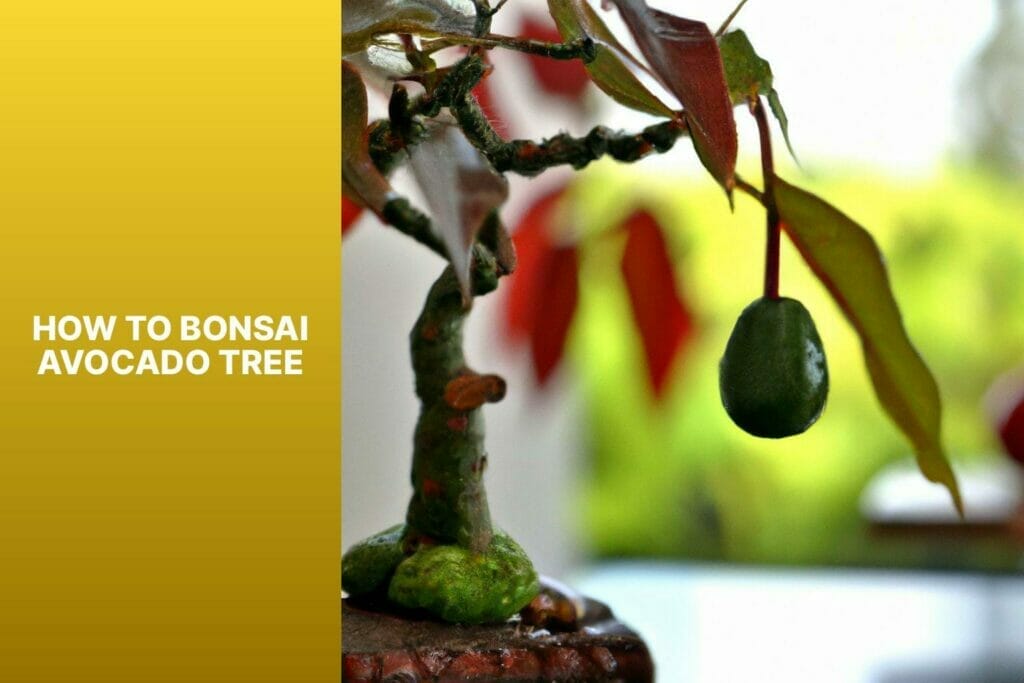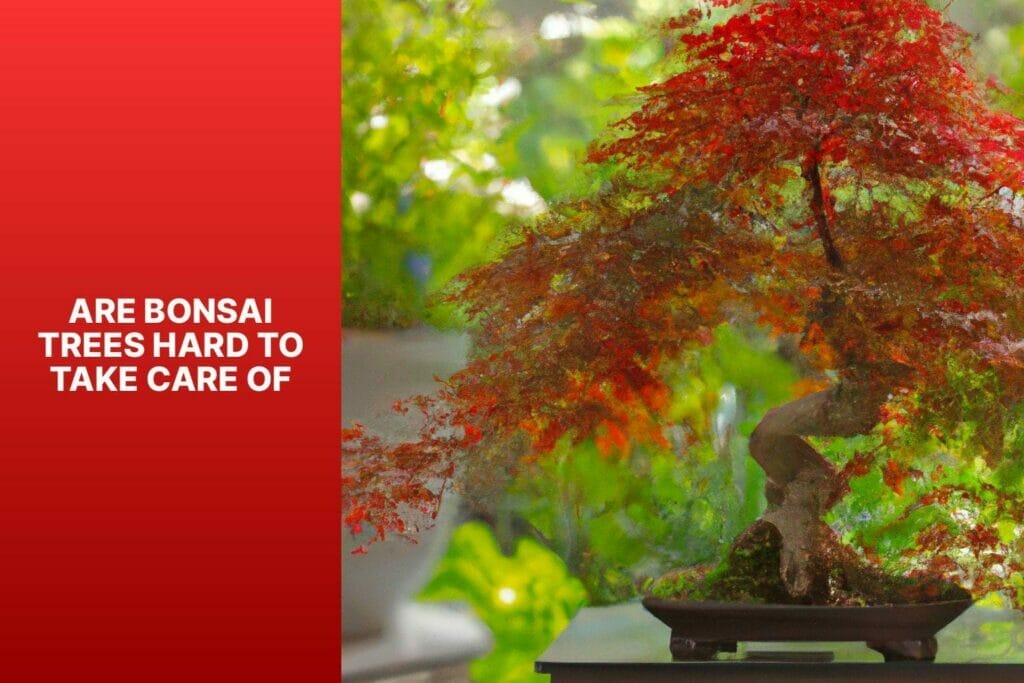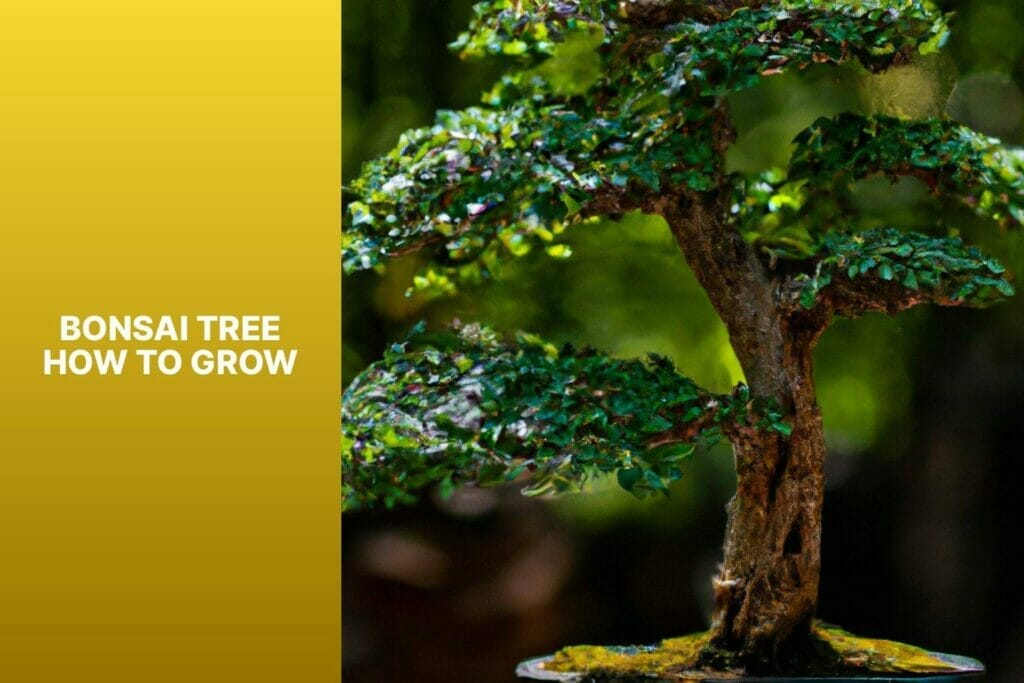Bonsai is an ancient Japanese art form that involves cultivating miniature trees in small containers, creating a miniaturized representation of a full-sized tree.
While typically associated with traditional bonsai varieties like juniper or pine, bonsai enthusiasts have also explored growing other types of trees, including the avocado tree.
In this article, we will explore the art of bonsai avocado tree cultivation and provide a comprehensive guide on growing and caring for these unique bonsai trees.
Choosing the right avocado variety is crucial when considering bonsai cultivation. Some avocado varieties are better suited for bonsai due to their dwarf size or small leaves, which make them more compatible with the miniature proportions of bonsai aesthetics.
We will explore different avocado varieties ideal for bonsai size and leaf structure.
To prepare the avocado tree for bonsai, specific techniques such as Pruning and trimming will be required to shape the tree and maintain its miniature size.
Root pruning and repotting are vital to ensure the tree’s health and growth in a confined container.
Shaping and styling a bonsai avocado tree is essential to bonsai artistry. Techniques like wiring and branch manipulation will be discussed to create the desired form and structure.
Caring for a bonsai avocado tree involves proper watering, moisture control, and appropriate fertilizing techniques to support its growth and development.
Sunlight and temperature requirements will also be addressed to ensure the tree thrives in its environment.
While growing a bonsai avocado tree can be an enjoyable and rewarding endeavor, it is not without its challenges. Common issues such as pest and disease management will need to be addressed, as well as avoiding pruning mistakes and facilitating the tree’s recovery.
Following the guidance and tips in this article, you will be well-equipped to embark on your bonsai avocado tree journey and create a stunning miniature representation of this beloved fruit-bearing tree.
Key takeaway:
- Growing bonsai avocado trees maximizes space: Bonsai techniques allow avocado trees to be grown in small containers, making them suitable for limited spaces such as apartments or small gardens.
- Choosing the right avocado variety is crucial: For bonsai, dwarf avocado varieties with small leaves are recommended as they are more suited for shaping and maintaining the miniature size.
- Proper care and maintenance are essential: Pruning, root pruning, and shaping techniques must be regularly applied to cultivate a healthy and aesthetically pleasing bonsai avocado tree.
Choosing the Right Avocado Variety for Bonsai
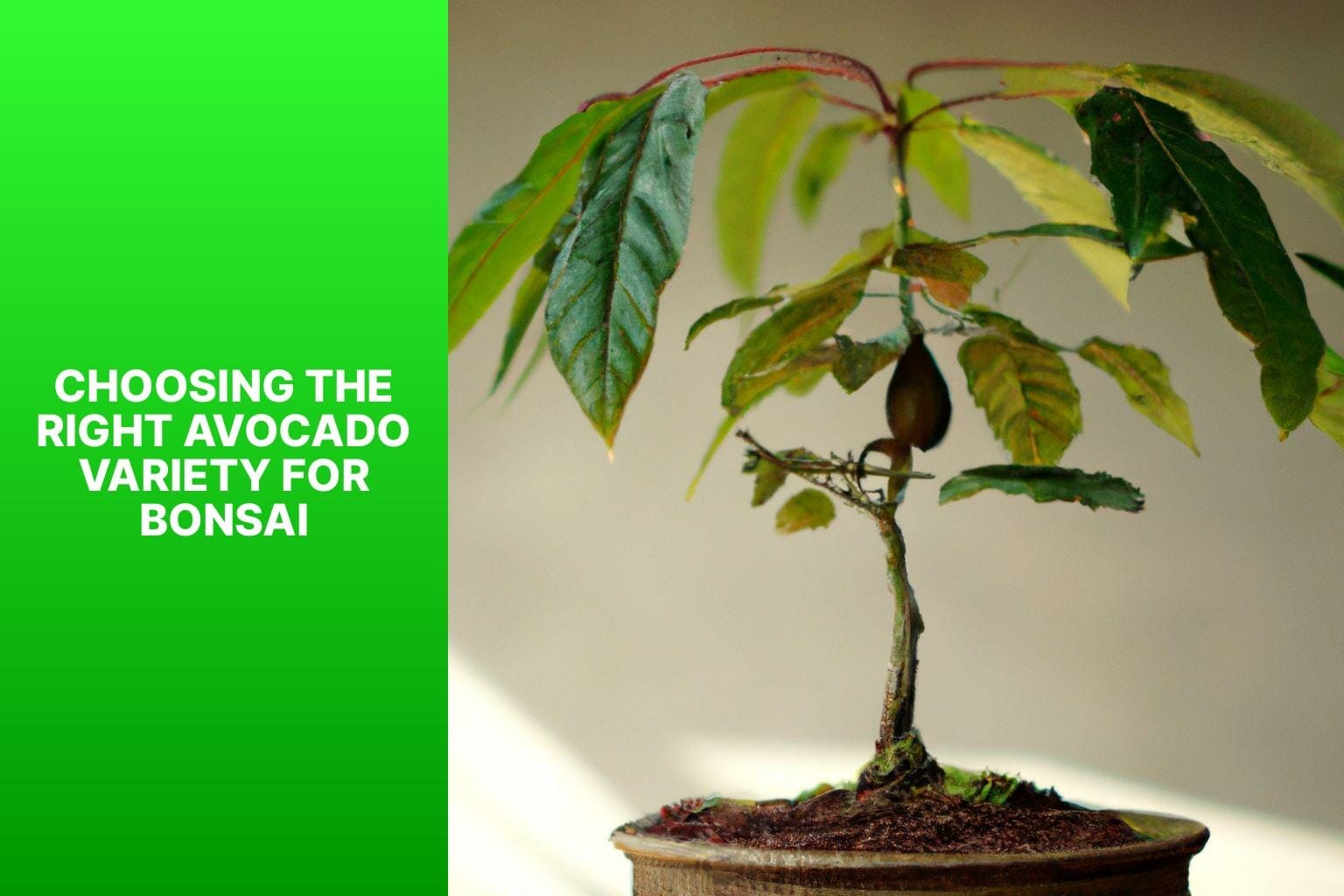
Photo Credits: Mnbonsainetwork.Com by Sean Rodriguez
Selecting the right avocado variety is key when creating a bonsai avocado tree. In this section, we’ll explore the world of avocado varieties perfect for bonsai enthusiasts.
From dwarf avocado varieties that provide compact foliage to varieties with small leaves that offer a beautiful aesthetic, we’ll explore the options for creating stunning and unique bonsai avocado trees.
Get ready to discover the perfect avocado variety for your bonsai project!
Dwarf Avocado Varieties
When it comes to dwarf avocado varieties, bonsai enthusiasts have several options. The Wurtz (Little Cado) is a small tree that reaches a maximum height of 8 to 10 feet, making it ideal for limited space.
The Joey variety is another compact option with a dense canopy, perfect for small areas. The Holiday avocado is a great choice if you prefer a slow-growing variety easily managed in a container.
The Gwen variety is perfect for bonsai enthusiasts who enjoy shaping their trees. It produces medium-sized avocados and adapts well to Pruning.
The Lamb Hass is a smaller version of the popular Hass avocado, known for its rich and creamy flavor.
When choosing a dwarf avocado variety for bonsai, consider the available space, your preferred tree size, and the desired flavor.
Each variety offers unique characteristics that enhance the aesthetics of your bonsai avocado tree. Happy bonsai gardening!
Varieties with Small Leaves
– Wurtz Avocado is one of the varieties with small leaves, making it perfect for bonsai cultivation. Its compact foliage creates a visually appealing miniature tree.
– Baby Queen Avocado is another well-known variety for its small leaves. This compact size allows easier shaping and styling, making it a favorite among bonsai enthusiasts.
– Picual Avocado is a dwarf variety that also has small leaves. Its petite foliage adds a delicate and intricate quality to the appearance of the bonsai tree.
– Simmonds Avocado is a versatile variety that can be trained into bonsai due to its small leaves. It balances leaf and tree sizes, allowing for greater control in shaping and styling.
– Lamb Hass Avocado is a unique variety with small leaves that are rich green. This particular variety is highly sought after for creating visually striking bonsai trees.
These varieties with small leaves are ideal for bonsai cultivation because their compact foliage allows for intricate shaping and styling.
Their petite size enhances the overall aesthetic appeal of the bonsai avocado tree, creating a visually pleasing miniature version of its full-sized counterpart.
Preparing the Avocado Tree for Bonsai
Regarding bonsai avocado trees, preparation is the key to success. This section details the crucial steps of preparing your avocado tree for bonsai’s captivating art.
From the delicate pruning and trimming techniques to the essential root pruning and repotting process, we’ll explore the secrets to creating a stunning bonsai avocado tree.
So get ready to unlock the beauty and grace within your avocado tree and embark on this enchanting bonsai journey!
Pruning and Trimming
Pruning and trimming are crucial for maintaining the health and shape of a bonsai avocado tree. These practices help control growth and keep the size in check.
Eliminating dead, damaged, or diseased branches is important to prevent infections. Trimming is performed to shape the tree and promote growth in specific directions.
For precise and quick cuts, it is recommended to use sharp bonsai shears.
The ideal time for Pruning is during the dormant season, typically late winter or early spring. To ensure a well-balanced appearance, monitoring and trimming excessive growth is essential.
Consider the overall design and the proportionate arrangement of branches for an appealing result. Learning the proper techniques and acquiring the necessary tools is key.
Patience is necessary, and carefully planning and executing each pruning session is crucial. Regularly assess the tree’s growth and make necessary adjustments.
Remember, Pruning and trimming are continuous processes contributing to the bonsai avocado tree’s overall health and aesthetic appeal.
Root Pruning and Repotting
Bonsai Avocado Tree
1. Gather the necessary tools and materials: pruning shears, root rake, bonsai soil, and a suitable pot for root pruning and repotting.
2. Carefully remove the avocado tree from its pot and loosen the soil around the roots using the root rake for root pruning and repotting.
3. Identify and prune damaged or excessively long roots using the pruning shears for root pruning and repotting.
4. Inspect the root ball for pests or diseases and take appropriate measures if present during root pruning and repotting.
5. Select a slightly larger bonsai pot with good drainage holes for future growth during repotting.
6. Place a layer of bonsai soil at the bottom of the new pot and position the tree in the center. Spread out the roots during repotting.
7. Fill the pot with bonsai soil, ensuring it is distributed evenly around the roots during repotting.
8. Press the soil lightly to secure the tree and remove air pockets during repotting and root pruning.
9. Thoroughly water the tree to settle the soil and encourage root growth after root pruning and repotting.
10. Find a suitable location for the repotted avocado bonsai tree with adequate sunlight and temperature conditions.
By following these steps for root pruning and repotting, you can ensure the health and vitality of your bonsai avocado tree. Monitor the tree’s progress and adjust watering and fertilizing for its well-being.
Shaping and Styling Techniques for Bonsai Avocado Tree
Shape and style your bonsai avocado tree with precision using proven techniques. Get ready to dive into the art of wiring and branch manipulation in this section.
Discover how these practices transform your bonsai avocado tree into a living masterpiece. Learn the secrets to creating captivating, breathtaking designs that capture nature’s essence.
Let’s explore the tools and methods to help you shape your bonsai avocado tree into a stunning work of art.
Wiring
Wiring a bonsai avocado tree requires proper techniques for desired shape and form. Consider the following aspects:
- Material: Use high-quality bonsai wire made from aluminum or copper. Choose the wire thickness based on branch thickness and flexibility.
- Timing: Wire during the dormant period to reduce the risk of branch damage.
- Technique: Start wrapping wire at the branch base and carefully wind it towards the tip. Avoid wrapping too tightly to prevent bark damage.
- Placement: Position the wire along desired branch shape. Ensure even spacing and no crossing.
- Duration: Leave wire on for a specific period based on tree growth rate and required shape. Regularly check for wire marks or constriction.
After wiring, closely monitor tree health and growth. Adjust and remove the wire once the branches are set in the desired position. Handle trees with care to avoid damage.
To enhance wiring skills, practice on smaller branches and seek guidance from experienced bonsai enthusiasts. Patience and dedication can shape your bonsai avocado tree into a beautiful masterpiece.
Branch Manipulation
Branch Manipulation is essential for shaping and styling a Bonsai Avocado Tree. Here are step-by-step instructions:
1. Choose branches based on the desired shape of your Bonsai tree.
2. Gently bend the branch in the desired direction using your fingers or Bonsai wire.
3. Avoid applying excessive force to prevent damage.
4. If the branch resists manipulation, gradually bend it over time to avoid harm.
5. Secure the branch in its new position with Bonsai wire, twisting it to hold it firmly.
6. Regularly check for signs of stress or damage and adjust the wire or branch position as needed.
7. Leave the wire for a few months until the branch sets in its new shape. Avoid leaving it too long to prevent marks or strangulation.
8. During the growth season, monitor and prune unwanted shoots or branches to maintain their shape.
9. Be patient and allow your Bonsai Avocado Tree time to adjust. Branch manipulation requires care and attention.
By following these steps, you can effectively manipulate the branches of your Bonsai Avocado Tree to create the desired shape.
Caring for Bonsai Avocado Tree
Discover the secrets to nurturing a thriving bonsai avocado tree!
In this section, we’ll delve into the art of caring for your bonsai avocado tree, focusing on essential aspects such as watering and moisture control, fertilizing techniques, and finding the optimal balance of sunlight and temperature.
Get ready to unlock the key to healthy growth and an abundance of delectable avocados with your bonsai avocado tree.
Watering and Moisture Control
Proper watering and moisture control are crucial for maintaining the health of a bonsai avocado tree. Follow these guidelines to achieve optimal hydration:
– Regularly assess the soil’s moisture level by inserting your finger approximately one inch deep.
– Only water when the top inch of soil has become dry. It is important to avoid overwatering, as this can lead to root rot.
– To prevent shocking the tree, it is best to use room-temperature water. A watering can with a narrow spout is ideal for this purpose.
– Ensure that water reaches the roots by watering slowly and evenly.
– It is important to avoid watering too frequently. Allowing the soil to dry out between waterings slightly will prevent waterlogging.
– For proper drainage and to prevent root damage, it is recommended to use well-draining soil and a pot with drainage holes.
– Adjust the frequency of watering based on the environmental conditions. During hot and dry periods, more frequent watering may be necessary.
– Keep an eye on humidity levels and provide additional moisture if required. Increasing humidity can be achieved by misting the leaves or using a water tray.
– During winter, reduce the watering frequency when the tree’s growth slows. Make sure that the soil does not completely dry out.
By following these guidelines, you can ensure proper watering and moisture control for your bonsai avocado tree, thus promoting its health and growth.
Fertilizing
When fertilizing your bonsai avocado tree, consider the following factors:
– Use a balanced, slow-release fertilizer specifically made for bonsai or fruit trees, with a ratio of nitrogen, phosphorus, and potassium (like 10-10-10 or 14-14-14) for healthy growth and fruit production.
– Fertilize every four to six weeks during spring and summer. Stop or reduce fertilizing in fall and winter. Adjust the frequency based on fertilizer instructions and tree response.
– Follow the recommended dosage on the fertilizer packaging. Avoid over-fertilizing to prevent salt buildup and root damage. Use a scale or measuring spoon for accuracy.
– Apply fertilizer evenly on the soil surface, avoiding contact with trunk or foliage. Water thoroughly after fertilizing to help nutrients reach the roots.
– Monitor trees regularly for nutrient deficiencies or excesses (yellowing leaves, stunted growth). Adjust fertilizer regimen or seek guidance from a bonsai expert if needed.
Fertilizing is crucial for your bonsai avocado tree’s growth and fruit production. Choose the right fertilizer, stick to a schedule, and monitor the tree’s response for optimal growth and vitality.
Sunlight and Temperature
Sunlight and temperature are crucial in properly caring for a bonsai avocado tree. These factors are vital for the tree’s growth and overall well-being.
Regarding sunlight, bonsai avocado trees require a minimum of 6-8 hours of direct sunlight daily. This is essential for photosynthesis, energy production, and the tree’s overall health.
Regarding temperature, avocado trees thrive at 60-85°F (15-29°C). They are sensitive to temperatures below 50°F (10°C). Keeping the bonsai avocado tree warm during colder months is important to protect its leaves and branches from frost and freezing.
To ensure optimal conditions, it is crucial to maintain a balance between sunlight and temperature. Extreme hot or cold locations can stress the tree and hinder its growth.
Therefore, it is important to closely monitor the levels of sunlight and temperature to promote the health and development of the tree.
Notably, avocado trees adapt to different climates but prefer warmer regions. In cooler climates, providing additional heat or using grow lights may be necessary to compensate for the lack of warmth.
Conversely, offering shade during the hottest part of the day is crucial in hot climates to prevent excessive heat from damaging the tree.
Considering these factors, you can create the optimal conditions for your bonsai avocado tree’s sunlight and temperature requirements. This will ultimately promote its growth and overall well-being.
Common Challenges and Problems in Bonsai Avocado Tree
Caring for a bonsai avocado tree comes with its unique set of challenges. This section will delve into the common hurdles and problems bonsai avocado enthusiasts face, from pesky pests to pruning mistakes.
Discover effective pest and disease management techniques, and learn how to prune your tree without causing irreversible damage. Get ready to tackle these obstacles head-on and ensure the health and vitality of your bonsai avocado tree.
Pest and Disease Management
Pest and disease management is of utmost importance regarding the health of bonsai avocado trees. It is essential to regularly inspect these trees for potential pests such as aphids, scales, and mites.
If pests are discovered, washing the affected areas with water or utilizing horticultural oil or insecticidal soap to eliminate them is recommended. Watching for diseases like root rot, fungal infections, or leaf spot is crucial.
To prevent fungal diseases, it is necessary to ensure proper drainage and avoid excessive moisture around the roots. If diseases are discovered, they should be treated with the appropriate fungicides or by pruning and removing the affected areas.
Implementing good cultural practices, such as providing ample sunlight and air circulation, is also important to deter infestations. It is advised to regularly clean and sterilize bonsai tools to prevent the spread of diseases.
Organic pest control methods should be utilized to protect the environment and beneficial insects, while excessive chemical pesticides should be avoided.
In cases requiring further guidance, seeking professional advice or consulting bonsai communities can provide specific pest and disease management strategies for avocado bonsai trees.
Pruning Mistakes and Recovery
Pruning is essential for the health of a bonsai avocado tree. It is important to avoid common pruning mistakes and know how to recover from them.
- Over-pruning can weaken the tree significantly. To help the tree regain strength, ensure it receives sufficient sunlight, water, and nutrients. Refraining from further Pruning until the tree has fully recovered is crucial.
- Making improper pruning cuts can cause harm or introduce disease. For precise cuts at the correct angles, it is recommended to use clean and sharp pruning tools. If incorrect cuts have already been made, cleaning the wound, applying wound sealant, and monitoring for any signs of infection or decay are important.
- Pruning should be done during the tree’s dormant period, typically in late winter or early spring. Pruning outside of this period may lead to stress or interrupt growth. If Pruning does happen at the wrong time, observe the tree for any negative effects and adjust the care accordingly.
- Neglecting the balance of branches can result in an unattractive or unstable tree. To rectify this, gradually prune and shape the branches to achieve a more balanced appearance.
Let’s share a true story about pruning mistakes and recovery:
An avid bonsai enthusiast, Tom mistakenly over-pruned his avocado tree to control its size. As a result, the tree became weak and struggled to produce healthy leaves.
Recognizing his mistake, Tom adjusted his care routine by ensuring proper sunlight and nutrients for the tree. He refrained from further Pruning and patiently waited for the tree to recover.
With time, the avocado tree bounced back, regaining strength and flourishing with lush foliage. Tom understood that moderation and proper timing are crucial factors in successful Pruning, allowing the tree to thrive.
Care Tips for Avocado Bonsai Tree
- Choose a container larger than the tree’s root ball for proper growth. Ensure the container has drainage holes to prevent waterlogging.
- Provide adequate sunlight by placing your avocado bonsai tree where it gets 6-8 hours of direct sunlight daily for healthy growth and fruit production.
- Water regularly by watering the tree when the top inch of the soil feels dry. Avoid overwatering to prevent root rot. Maintain consistent moisture without waterlogging.
- Fertilize periodically by using balanced, organic fertilizer to provide essential nutrients. Follow package instructions to apply fertilizer every 4-6 weeks during the growing season.
- Prune and shape the tree regularly to maintain the desired shape and promote bushier growth. Trim dead or overgrown branches for a healthy appearance.
- Monitor for pests like aphids or spider mites. Treat with appropriate insecticide if infestation occurs.
- Protect from extreme temperatures by moving the avocado bonsai tree indoors or providing insulation during winter to prevent damage.
Following these care tips, your avocado bonsai tree will remain healthy and thrive in your home or garden.
Health Benefits of Avocado
The health benefits of avocados are numerous. Avocados contribute to overall well-being.
Avocados are a great source of heart-boosting monounsaturated fats. They also contain essential nutrients like vitamins K, C, E, potassium, and folate. These nutrients support bodily functions and promote a strong immune system.
Avocados are an excellent source of dietary fiber, aiding digestion and maintaining a healthy weight. Avocado’s natural oils nourish the skin and promote a youthful appearance. They are also rich in antioxidants, protecting the skin from damage caused by free radicals.
Despite being high in calories, avocados can aid weight management. The high fiber and healthy fat content keep you full, reducing overeating. Avocados contain lutein and zeaxanthin, antioxidants essential for good eye health and preventing age-related macular degeneration.
To enjoy the health benefits of avocados, add them to your diet by slicing them into salads, spreading them on toast, or using them as a substitute for mayonnaise or butter in recipes. Indulge in the health benefits of avocado and its creamy deliciousness in meals.
Growing Avocado Bonsai from Seeds
To successfully grow an avocado bonsai from seeds, you should follow these steps:
- Start by selecting a ripe avocado and carefully removing the seed.
- Take the seed and thoroughly rinse to eliminate any remaining fruit. Then, insert toothpicks into the sides of the seed to suspend it over a glass of water, ensuring the bottom half is submerged.
- Find a warm and sunlit spot to place the glass, and remember to change the water every few days.
- After a couple of weeks, you will notice the seed splitting open and a stem beginning to emerge. Allow it to continue growing in water until the roots reach a length of about two inches.
- It’s time to prepare a bonsai pot that has well-draining soil. Carefully plant the avocado seed in the pot, covering the roots with soil.
- Choose a bright location for the pot, but avoid direct sunlight to prevent any potential damage from scorching.
- Regularly water the bonsai, ensuring that the soil remains moist without becoming overly saturated.
- Prune the seedling by removing unwanted branches or leaves to shape your bonsai tree.
- For healthy growth during the growing season, fertilize the bonsai with a water-soluble fertilizer containing a balanced nutrient mix.
- Keep an eye on the growth of your avocado bonsai, and as it continues to develop, repot it into a larger container as necessary.
Following these instructions, you can enjoy growing your avocado bonsai tree from seeds.
Tools and Materials for Bonsai Avocado Tree
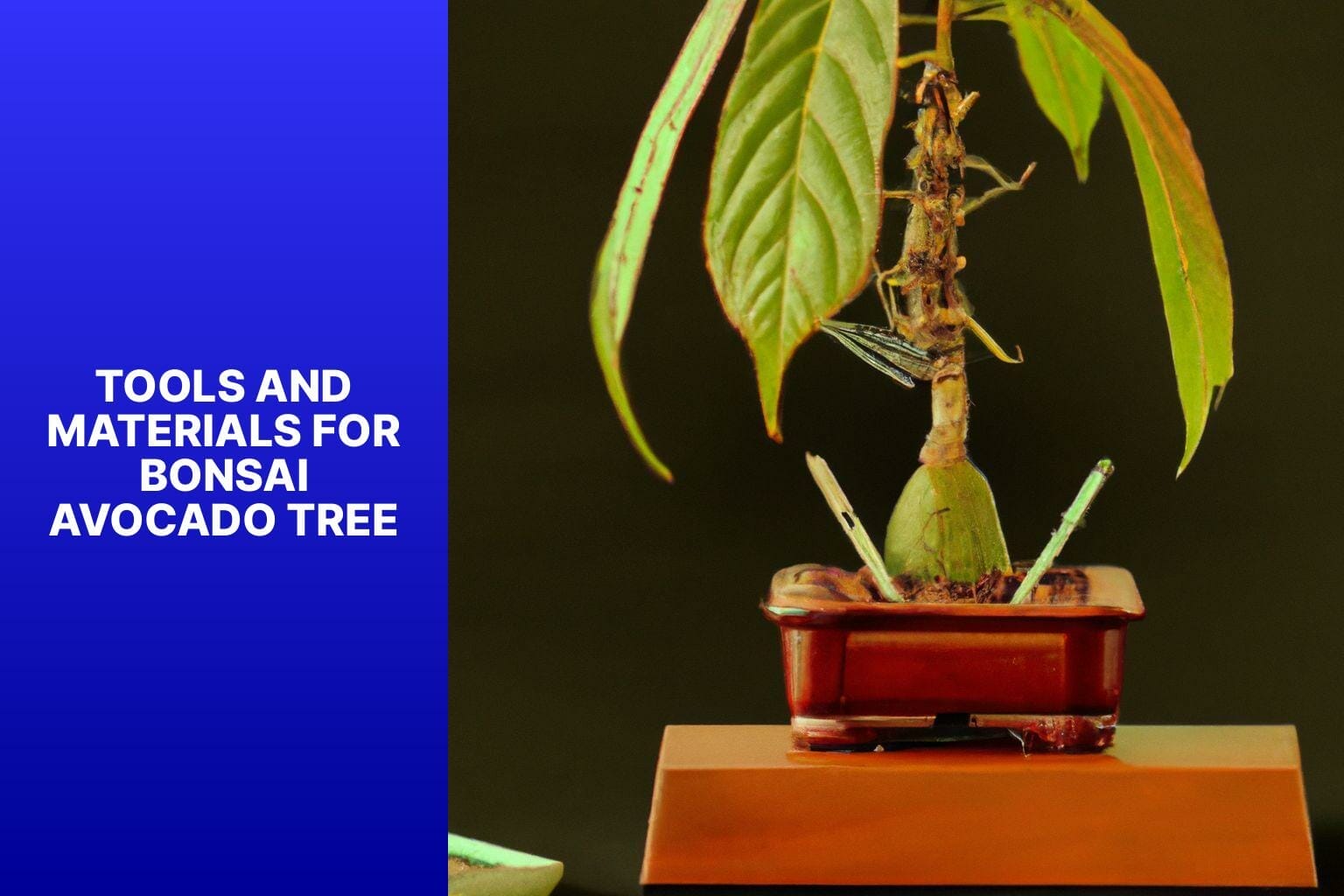
Photo Credits: Mnbonsainetwork.Com by Jerry Lopez
Bonsai avocado trees require the right tools and materials for proper care and maintenance.
- Pruning shears trim and shape branches and foliage.
- Wire gently bends and shapes branches into desired positions.
- A well-draining bonsai soil mix from organic and inorganic materials promotes healthy tree growth.
- A shallow, bonsai-specific pot allows for proper drainage and adds aesthetic appeal.
- A slow-release fertilizer formulated for bonsai trees provides the necessary nutrients for healthy growth.
- Moss can enhance the bonsai tree’s appearance and help retain moisture in the soil.
- Use a watering can with a fine nozzle to gently and evenly water the tree, avoiding excessive water flow and damage.
Fact: Proper care and attention to bonsai avocado tree tools and materials enhance cultivating a healthy and stunning miniature tree.
Bonsai Avocado Tree Aesthetic Characteristics
– Bonsai avocado trees have a unique and visually appealing appearance, making them aesthetically pleasing.
– The pruning process in bonsai helps maintain the desired shape and size of the avocado tree, ensuring its aesthetic characteristics.
– Bonsai avocado trees have smaller leaves than their full-sized counterparts, enhancing their aesthetic appeal.
– Careful trunk formation in bonsai avocado trees adds age and character to their aesthetic beauty.
– Bonsai avocado trees are often displayed in beautiful, unique containers that complement their aesthetics and enhance their appearance.
– Regular root pruning in bonsai avocado trees promotes a compact root system and maintains their small size, contributing to above-ground and below-ground aesthetics.
Bonsai Avocado Tree Step-by-Step Process
Creating a bonsai avocado tree requires following a step-by-step process:
- To start, obtain a small avocado plant or seedling that is ideally a few months old.
- Select a suitable bonsai pot that is shallow and provides good drainage.
- Create the potting mix by combining equal parts of well-draining soil, sand, and peat moss.
- Carefully remove the avocado plant from its original container and trim the roots to encourage a compact, bonsai-like appearance.
- Add a layer of the prepared potting mix at the bottom of the bonsai pot.
- Position the avocado plant in the center of the pot and surround it with more potting mix to cover the roots and stabilize the plant.
- Shape the branches and foliage of the avocado plant to achieve a balanced and aesthetically pleasing form using small pruning shears and making clean cuts.
- Thoroughly water the bonsai avocado tree, ensuring the soil is evenly moist but not soggy.
- Place the bonsai tree in a location with bright, indirect sunlight.
- Monitor the soil’s moisture levels and water the tree when the top inch feels dry.
- Fertilize the bonsai avocado tree with a balanced, slow-release bonsai fertilizer following the instructions on the package. Apply fertilizer once every two months during the growing season.
- Regularly inspect for pests or diseases and take appropriate measures if any issues arise.
- Trim and shape the bonsai avocado tree to maintain its desired form.
- Enjoy the rewarding process of cultivating and nurturing your beautiful bonsai avocado tree!
Tips for Growing Bonsai Trees Indoors
Tips for Growing Bonsai Trees Indoors
– Choose the right tree species: Select Ficus, Jade, or Chinese Elm, species that thrive indoors.
– Ensure proper lighting: Place bonsai trees near a south-facing window or provide artificial grow lights for bright, indirect light.
– Monitor temperature and humidity: Maintain temperatures between 60-75°F (15-24°C) and humidity levels around 50-60% using a humidifier or pebble tray.
– Watering schedule: Water when the topsoil feels slightly dry, usually every 2-3 days. Avoid overwatering or letting the soil dry out completely.
– Fertilize regularly: Following the package instructions, use a balanced liquid fertilizer during the growing season to nourish the tree and promote healthy growth.
– Pruning and shaping: Regularly trim excess growth and shape the branches to maintain the desired bonsai form. Use sharp pruning shears for clean cuts.
– Repotting: Refresh the soil and encourage root growth by repotting the bonsai every 2-3 years. Use well-draining bonsai soil and trim the roots during repotting.
– Protect from pests: Inspect bonsai regularly for aphids or spider mites and treat any infestations immediately with organic insecticides.
– Regular maintenance: Dedicate time to care for your bonsai, checking for diseases, adjusting watering needs, and removing dead leaves or branches.
Following these tips for growing bonsai trees indoors, you can create a beautiful and thriving miniature tree in your home.
Recommended Products for Bonsai Avocado Tree
When it comes to caring for bonsai avocado trees, it is crucial to choose the right products. Here are some products that we recommend for your consideration:
1. Bonsai soil: Using a well-draining soil mix specifically designed for bonsai trees is important. The Bonsai Jack Succulent and Cactus Soil Gritty Mix is highly recommended as it balances moisture retention and drainage perfectly.
2. Pots: Select a shallow bonsai pot for proper root development. We suggest the BonsaiOutlet Plastic Bonsai Training Pot, which is both durable and affordable.
3. Fertilizer: Nourish your bonsai avocado tree with a balanced organic fertilizer. The Bonsai-Pro Professional Bonsai Fertilizer is an excellent choice as it provides essential nutrients without damaging the delicate roots.
4. Pruning shears: High-quality bonsai pruning shears are essential to maintain the desired shape of your bonsai avocado tree. Consider using the Kaneshin Bonsai Shears for precise and clean cuts.
5. Wire: Shape and train the branches of your bonsai avocado tree using aluminum bonsai wire of the appropriate thickness.
Pro-tip: Before purchasing any product, consider the specific needs of your bonsai avocado tree. Ensure that the products you choose are suitable for the size and age of your tree to promote healthy growth and development.
Some Facts About How To Bonsai Avocado Tree:
- ✅ Growing an avocado bonsai tree requires patience and care. (Source: https://gardeningforu.com/grow-an-avocado-bonsai/)
- ✅ To start growing an avocado bonsai tree, choose a variety suitable for your climate and well-drained bonsai soil. (Source: https://www.gardeningdream.com/how-to-bonsai-an-avocado-tree/)
- ✅ Pruning, training, and occasional wiring are necessary to shape the branches of an avocado bonsai tree. (Source: https://about-bonsai.blogspot.com/2018/02/can-i-bonsai-avocado-plant.html)
- ✅ Avocado bonsai trees require bright, warm conditions and regular watering to thrive. (Source: https://plantpaladin.com/can-you-bonsai-an-avocado-tree/)
- ✅ Avocado bonsai trees can be wired using copper or aluminum wire and should be repotted every one to two years. (Source: https://plantpaladin.com/can-you-bonsai-an-avocado-tree/)
